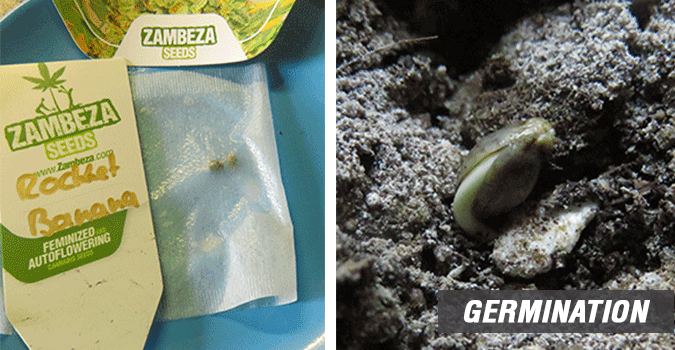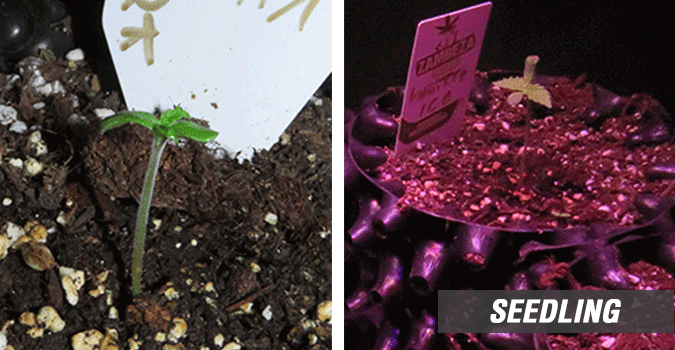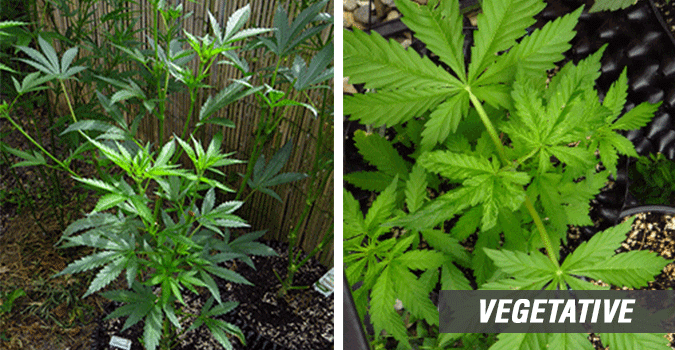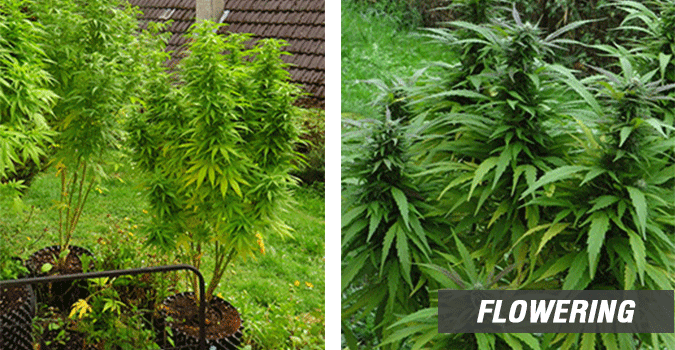Growing Stages Of The Cannabis Plant
Published : Nov 22, 2019

We examine the different growing stages of cannabis, and the requirements you as a grower must fulfil during each one. Read on to learn about optimal light cycles, timelines, and other useful info.
Cannabis plants go through different stages during their growing cycle. If you want to cultivate superb weed, it’s crucial to familiarise yourself with each stage, and what it means for proper plant care. Just like you wouldn’t feed steak to a baby or live off baby food as an adult, your plants have different nutrient and light requirements depending on their age and environment.
THE GROWING CYCLE OF A CANNABIS PLANT
The growing cycle of a cannabis plant can be divided into four main categories:
• Germination stage
• Seedling stage
• Vegetative stage
• Flowering stage
Some of these stages can be broken down even further into more categories, but we will focus on the broader stages for the duration of this article.
Here’s what you need to know about each of these stages, so you can reap the rewards of optimally grown bud!
GERMINATION STAGE
![]() Duration: 2–10 days
Duration: 2–10 days
![]() Light: -/-
Light: -/-
Let’s assume you just received some awesome cannabis seeds. You can recognise quality pretty easily just by touching and looking at them. Good seeds normally have a light-to-dark-brown colour, and feature a shiny, polished-looking shell with a subtle tiger stripe pattern. They should feel hard to the touch. Cannabis seeds that are bright green or white and feel soft are undeveloped and will likely not germinate.
Your cannabis seeds are just waiting to spring to life. To achieve this, they need moisture and warmth. There are several ways you can successfully germinate your seeds: You can do so between a few pieces of moist paper towel, in a glass of water, or simply by planting them directly in soil-filled containers. The latter is our recommended method, as the others can make your seeds rot, or damage their sensitive taproots when you move them to their growing container.
Once the seeds have “popped”, which can take anywhere from 2–10 days (quality seeds like those from Zambeza will usually pop in just a few days), a taproot will emerge that grows downward into the soil while the stem surges upward. The first two leaves of your baby cannabis plant—small, roundish leaves called cotyledons—are now emerging from their protective shell.
GERMINATION STAGE: OPTIMAL CONDITIONS
Your seeds require moisture and warmth to germinate. If you germinate in a seedling pot, you can use a humidity dome or can cover the pot with cling wrap to keep humidity levels high. For best results, germinate your seeds at a temperature of 22–25°C.
Germinating seeds do not require light, and should be kept in a dark location like a cupboard if using the paper towel or glass of water methods. But as soon as your freshly sprouted seedlings emerge from the soil, you need to make sure you provide them with a low amount of (the right kind of) light.
Once your cannabis seeds have sprouted and developed roots, as well as their first set of “true” leaves, this is when the seedling stage begins.

SEEDLING STAGE
![]() Duration: 2–3 weeks
Duration: 2–3 weeks
![]() Lighting: 18h on / 6h off
Lighting: 18h on / 6h off
When your cannabis plant has emerged from the soil, it is technically already a seedling. But some growers consider the seedling stage to begin when the sprout shows its first set of serrated cannabis fan leaves, which appear a few days after the round cotyledons. Still, your seedling’s first fan leaves will only consist of single blades, later developing the iconic 5–7-blade leaves once the plant is growing full-speed. By the time your seedling has developed 4–6 sets of these single-fingered cannabis leaves, this is when growers say the seedling stage has ended and the vegetative stage has begun.
SEEDLING STAGE: OPTIMAL CONDITIONS
In the seedling stage, your cannabis plant is still very vulnerable. For instance, excess moisture can lead to mould/fungus, which is a real threat given your seedling’s meagre defences. Their root system has not yet developed, so they cannot take up much water. This puts them at high risk of overwatering, so be careful not to drown them. At this point, if you are growing in soil, your young weed plant should not require any extra nutrients. The cotyledons will produce all the nutes your seedling needs to promote root growth. Moreover, most potting mixes already contain nutrients for at least the first 3–4 weeks. Know that many beginner growers make the mistake of overfeeding their young cannabis plants.
Seedlings do best at a temperature of 20–25°C. Your grow light should be set to an 18/6 light cycle, which is a sufficient amount to promote vigorous growth.

VEGETATIVE STAGE
![]() Duration: 3–16+ weeks
Duration: 3–16+ weeks
![]() Lighting: 18h on / 6h off
Lighting: 18h on / 6h off
The vegetative stage is when your cannabis plant puts its energy into developing foliage and a robust main stem. The beginning of the veg stage is normally when you’d transplant your plant into its first larger pot. Depending on which strain you’re growing, you should begin to see some morphological differences come to the fore. Indicas often grow short and bushy, displaying broader leaves and less space between nodes (bud sites). Sativas, on the other hand, tend to grow tall and lanky, with larger internodes and more slender leaves.
VEGETATIVE STAGE: OPTIMAL CONDITIONS
With your cannabis plant in full growth, you’ll want to water it well and provide it with sufficient nutrients, particularly nitrogen. The exact amount of nutrients your plant will need varies from strain to strain, and can depend on the growing vigour and environment of the specimen. To err on the side of caution, start out with half the recommended dosage of cannabis nutrients. If needed, you can always increase to full-strength.
As long as your light is set to a 18/6 schedule, the vegetative stage of your photoperiod cannabis plants can, in principle, last forever. In practice, however, you’ll want to limit vegging time, usually determined by the available space in your grow room. A typical duration for your plants to veg is anywhere from 3–16 weeks. Two exceptions are if you are growing in a SOG—in which case you’d likely skip the vegetative stage entirely—or if you’re keeping mother plants for an indefinite period.
The vegetative stage ends when you switch the light cycle to 12/12, or when light hours naturally decrease as the seasons change outdoors.

FLOWERING STAGE
![]() Duration: 8–11 weeks
Duration: 8–11 weeks
![]() Lighting: 12h on / 12h off
Lighting: 12h on / 12h off
The flowering stage is when your cannabis plant puts most of its energy into developing buds. However, during the first few weeks (a stage called pre-flowering or the flowering stretch), the change in light cycle causes plants to experience a period of accelerated growth in which some cultivars can double in height and develop multiple bud sites. Other specimens undergo less drastic changes. In either case, plants will now be displaying sex characteristics. In feminized cultivars, you should see more and more thin, white pistils forming on the nodes, indicating the buds to come.
When plants are done stretching, their nutrient requirements will change. Instead of requiring more nitrogen to power growth, plants now need a potassium-rich diet to support bloom. The duration of the flowering stage depends largely on the strain you’re growing, and on personal preference. Many indicas and hybrids bloom relatively quickly—ready to harvest in 8 weeks or less. Sativas, by comparison, can flower for 10 weeks or longer, with some commercial strains requiring up to 14 weeks. Make sure to have an idea of how long your plants are supposed to flower (usually indicated by the seedbank) to avoid harvesting too early or late.
FLOWERING STAGE: OPTIMAL CONDITIONS
Out in nature, cannabis starts flowering when the daylight hours decrease as autumn approaches. Indoor growers initiate flowering by switching their light cycle from 18/6 to 12/12. It is important that your flowering ladies receive an undisturbed 12 hours of darkness when in bloom. If this dark period is interrupted for any reason, it can cause your plants to revert back to vegetative growth, and you will end up with poor yields.
During the flowering stage, plants prefer less moisture in the air than during veg. As buds get denser and there’s less room for air to circulate, plants become susceptible to mould and rot, which could completely wreck your harvest. Avoid this by keeping relative humidity below 50% and gently blowing a steady stream of air across your plants with a standing fan.
At the end of the flowering phase, when your cannabis plant has grown you a bunch of thick and juicy buds, you can finally take your clippers out and get to work. You can be sure your plants are ready to chop once around 75% of trichomes have turned from clear to cloudy, perhaps with a select few showing mature amber hues.
It’s harvest time!







































